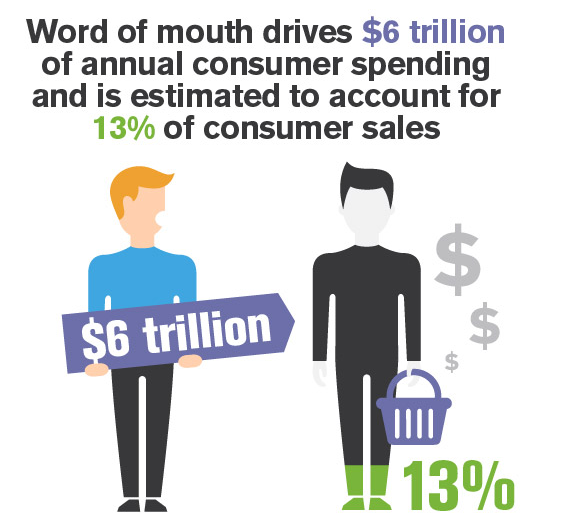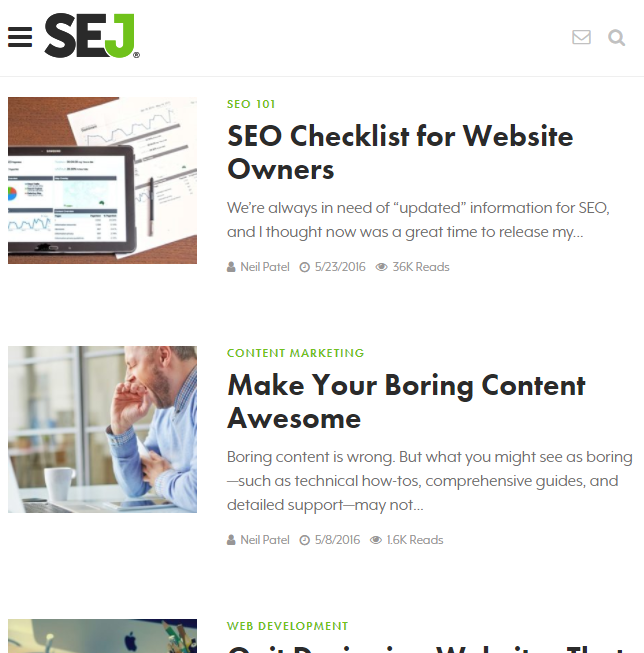You know what’s been on my mind lately? The importance of the B2C relationship.
Okay, hear me out.
Long before the days of ecommerce, most small businesses sold to the people in their town.
Business owners and employees developed connections with these people.
Maybe not “hey, how are the wife and kids?” connection, but consumers typically knew who they were doing business with.
With the explosion of ecommerce, you’d expect those relationships to be valued less and less.
But if the B2C interactions on social media are any indication, it’s becoming clear that people still want to do business with people.
Just look at how powerful word-of-mouth marketing is in the world of the modern consumer, according to this infographic from Business 2 Community.
What does this mean for the average business owner?
Well, it means that if you want to ensure that you’re developing your brand (online or otherwise), you’re going to need a focus on connections.
And the easiest way to put the focus back on connections is to develop your personal brand.
The value of the personal brand is something that businesses around the world are slowly starting to realize.
When handled properly, having a single person as the face of your business can end up being an incredibly powerful marketing tool.
But how do you go about developing that personal brand in the saturated digital media marketplace of today?
I get it, this is a bit of a confusing topic.
And frankly, there hasn’t been a lot of chatter about how to consistently reproduce the results of successful personal brands.
But that’s what this guide is for.
Every business is different, which means that not only will your audience’s needs be different, but so will the people running the business.
That being said, these are the steps that anyone looking to strengthen their personal brand should start with.
Personal branding might be tough, but armed with the right tools and the right approach, it has the potential to drastically change the way people view your business.
Make sure you’ve got a plan in place
Okay, so this probably sounds like your typical ‘brainstorm ideas’ section, right?
Wrong.
Planning out your strategy is always going to be important when it comes to digital media marketing. That’s just the nature of the beast.
But no type of marketing demands more from you in the planning stages than personal branding.
Keep in mind that when it comes to marketing, a person has way less elasticity than a business does.
Don’t believe me? Think about this for a second.
Celebrities have struggled with the perils of marketing for decades.
Sure, being seen as the comedian made getting comedy roles easy, but it made it impossible to get dramatic or action roles.
And if you expect the average consumer to treat you any differently, you’re in for a rude awakening.
Consumers see you how you choose to present yourself. But once you’ve been put into a category, it’s almost impossible to break away from it.
Businesses get new CEOs. But you’re stuck with your reputation indefinitely.
Which is why it’s so crucial to nail your first impressions with your audience.
Determine what you want your personal brand to look like. A clearly defined vision can be the difference between a boring personal brand and an engaging one.
One of my favorite examples of this is the personal brand of Tim Ferriss.
If you’ve been in the tech/entrepreneur scene for any amount of time, it’s almost impossible to avoid hearing about him.
His book The 4-Hour Workweek has basically become required reading for anyone in the entrepreneurial field.
Tim Ferriss is many things (angel investor, entrepreneur, tango world record holder), but above all else, he provides value in unique, interesting ways.
Let’s take a look at a video Tim recently released on YouTube on the topic of starting a business.
Throughout the video, he does exactly what you’d expect. Offers advice to people based on his experiences and understanding of the business world.
But if you take a closer look, you’ll notice something interesting.
Despite the fact that he’s giving you advice on how to start a business, at no point does he take himself too seriously.
In fact, he even manages to make the time to tell stories. Everything from that time he read a book at Burning Man to the story of an artisan leather worker who makes leather pants.
This video, and really his entire brand, revolves around providing a healthy balance of value and humanity.
No matter what the topic is, you can always expect Tim Ferriss to share content the same way. Tackling all the key points but never sacrificing his personality for the sake of professionalism.
His secret to success when it comes to connecting with his audience isn’t developing some mysterious, elusive tactic that only some people can reproduce.
If you want a personal brand like his, you have to present your audience with tangible, actionable value on a regular basis.
Seriously, it’s that simple.
And that’s my point. Your strategy when it comes to a personal brand doesn’t have to be overly complex or layered.
You just need to have a clear vision of how you want to present yourself and how you want your brand to be thought of.
How do you pull that off?
I’d argue that the critical first step here is to start by defining your target audience.
Not only will this make it easier in terms of figuring out what kind of content your personal brand should produce, but it’ll help you determine how to present that content.
You wouldn’t talk to an audience of millennials the same way you talk to a group of C-level execs, would you?
Once you’ve decided on your target audience, just follow the same process you would when constructing a buyer persona.
Identify pain points, common interests and trends, the usual.
Arming yourself with a strong understanding of your audience and a clear vision for the future of your personal brand isn’t just ‘helpful’. It’s the foundation on which your brand should be built.
Gain meaningful exposure
Having a clear strategy in place is great, but it means nothing if you’re not getting people’s attention.
And let’s face it. Getting people to pay attention to your personal brand is going to be an uphill battle.
Fortunately, there are a few things you can do to tip the scales in your favor.
First order of business? Start leveraging the heck out of free exposure.
I mean it! Any form of free exposure that you can get your hands on, you need to be taking advantage of it.
My preferred method? The guest post.
It may not be fancy or nuanced, but it’s easily one of the most effective ways to get people to notice your brand without spending a dime.
If you’re not familiar with guest blogging, let me paint a quick picture.
Blogs, and the people that run them, have a business that’s built on constantly providing people with content.
In other words, the more relevant content they can provide for their audience, the better it is for their business.
That’s where you come in.
You offer to write some unique, valuable content that’s specifically tailored to their audience’s needs.
After they agree to let you plug your business at the end of the article, you’re well on your way to that free exposure!
And not just ‘free’, by the way. Assuming you did your homework and picked a blog that’s read by plenty of your target audience, you’re also looking at targeted exposure.
The best part? You can keep doing over and over again.
Just look at all the content I’ve published on Search Engine Journal!
It’s not like the blog is suddenly going to need less relevant content.
There’s no reason you can’t develop a relationship with these blogs and regularly take advantage of the free exposure they give you by producing multiple articles for them.
But let’s say you’re looking to go beyond free exposure. Frankly, if you can afford to pay for advertising, you should.
The question then becomes “where should I invest in marketing my personal brand?”
There are plenty of options here, but for the sake of keeping things simple, we’re going to be looking at two examples.
- Paid ads on social media
- Social media influencers
When it comes to paid ads on social media, there are plenty of reasons to sign up.
The sheer volume of people on social media. Increased likelihood of online conversion. The fact that it’s infinitely cheaper than even the cheapest tv ad. Take your pick.
I’ve already covered the inner workings of effective social media ads before, so I won’t bore you by repeating myself.
What I do want to discuss is how you should approach the process of promoting your personal brand through social media ads.
Because actually executing a marketing campaign as a personal brand can be pretty difficult, if you don’t know what you’re doing.
I’ll just say it. There’s a fine line between delusional self-promotion and legitimately offering value to your audience.
Should be showcasing the immense value of your personal brand by showing people what’s possible via your products and services? Absolutely.
Heck, I do it all the time with my blog.
But I’ve noticed a concerning amount of small business owners who treat this as an opportunity to make baseless claims, in an attempt to trick people into visiting their page.
Aside from being ethically questionable, it’s also counterproductive.
People don’t want to do business with scam artists. You and I know that you have legitimate value to offer, but all they’re seeing is an ad that says “become a millionaire today!”
You’re not a scam artist, you’re a business owner. Make sure that your marketing reflects that.
Find that sweet spot between the height of success with your product and the real value that your audience will be able to extract from you and your business.
But if social media ads aren’t your style, or you aren’t experiencing much luck with them, there’s one more method you should start implementing.
It’s amazing to me that people are even willing to question the value of the social media influencer.
No one would claim that Nike is wasting millions of dollars sponsoring athletes.
Yet there are plenty of people that question the value of a business owner sponsoring a popular YouTube celebrity.
Whether you resonate with social media influencers or not, there’s no denying the numbers.
King Bach, who’s built his entire following off of social media, has managed to build a pretty respectable following despite not being a ‘traditional celebrity’.
Social media influencers can have hundreds of thousands, if not millions of followers.
But honestly? It’s bigger than a follower count. Conventional celebrities might have millions of followers on social media, but how often do they actually interact with them?
I’d say somewhere between rarely and never. For better or worse, that’s just part of the celebrity culture.
Social media influencers, or micro-celebrities, typically have a different relationship with their followers.
How?
Well, they actually have a relationship with them!
Most celebrity follower communities operate in a passive way. The celebrity posts something, and the community discusses it amongst themselves.
Here’s a look at a post on the Kylie Jenner Instagram page, promoting a pair of BeatsByDre headphones.
It’s a fine piece of promotion, and does a great job drawing attention to their product.
But there’s a big difference between posting something and actually communicating with your audience.
Let’s take a look at someone like Gary Vaynerchuk.
Micro-celebrity communities are met with constant interaction from their celebrity.
Right off the bat, it’s worth noting that Gary has a fraction of the followers that Kylie Jenner has.
That being said, Gary is infinitely more likely to like a comment and have a legitimate dialogue with someone on his page than Kylie is.
In fact, Gary Vaynerchuk interacts with his followers every time he posts, selecting winners for his ‘60 second club’, which rewards people who’ve turned on post notifications on Instagram.
Why does any of this matter?
Because it’s about engagement. A community that has a stronger relationship with the influencer is more likely to take what they say seriously.
It’s really an issue of quality over quantity.
Could you pay millions of dollars to promote your personal brand via a traditional celebrity? Of course you can.
But you could also just pay a fraction of the cost and get access to a targeted audience of millions of people.
I mean, I know which one I’d be willing to pay when it comes to promoting my brand.
Heck, sometimes you don’t even have to pay for it!
Plenty of social media influencers would love to have you share your expertise with their audience.
Just take a look at this interview I did with Tai Lopez, where I was able to share my insights with tons of people by leveraging Tai’s incredible social media presence.
Will the average business owner with no established personal brand be able to get free exposure from an influencer with nearly 1 million followers on YouTube alone? Maybe not.
But can that same business owner reach out to 10 influencers with 100,000 followers and work with them to promote their personal brand? Absolutely.
As long as you’re able to provide value to their audience, there’s no reason that they wouldn’t be open to an interview with an industry professional such as yourself.
Conclusion
I’m a huge believer in the power of personal branding.
I honestly believe that tapping into the humanity behind your business is one of the easiest ways to connect with your audience.
I also believe that it’s one of hardest forms of marketing to pull off, simply because people aren’t sure about how they should approach it.
Plan out what your personal brand should look like, what it’ll need to connect with your target audience, and how you’ll convey your message to them.
Take advantage of all the advertising methods at your disposal. Anything you can use to draw attention to your personal brand should be leveraged aggressively.
Learn to recognize free opportunities for exposure like guest blogging and interviews, while also using paid forms of advertising like social media ads and sponsoring social media influencers.
Personal branding is, at its core, a way to reinject humanity into your marketing.
By channeling the spirit of social media (the need to connect with others), you’ll be able to break through and reach a consumer that’s been fatigued by generic ads.
With this simple two-step process, any business owner out there can start to learn how to build and implement a personal branding strategy that does wonders for their business.
What do you think the most important aspect of a personal brand is?














Comments (0)